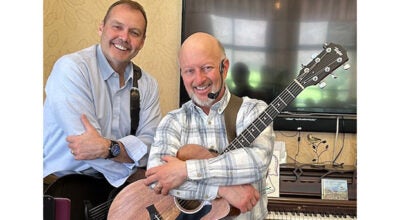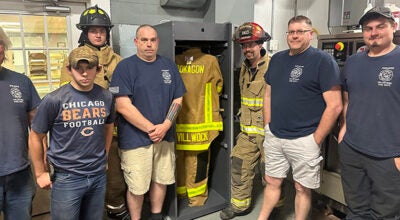Pictures worth a thousand words to Pokagon Band
Published 5:42 pm Thursday, January 30, 2014
Every purposeful picture tells a story, recycling and re-energizing symbols.
“We can’t make anything on a whim. It always has to have meaning,” Pokagon Band of Potawatomi cultural specialist Jefferson R. Ballew IV explained Jan. 29 at Southwestern Michigan College.
“We take pride in being able to utilize anything with ingenuity to make it our own,” he said, emphasizing “Injunuity” with air quotes. “Mink and otter from old stoles found at Goodwill.”
“We don’t waste anything,” he said. Deer hide can be leggings or stretched taut across drum heads. Dancers shake deer toenails.
“I try to utilize things in creation that are graceful and agile. I try to emulate how grass moves. As a male traditional dancer, I’m supposed to tell you a story. In May at Rodgers Lake will be the traditional Pokagon Band pow wow. When we can understand one another’s culture, it gives us the opportunity to be part of each other’s lives socially.”
Ballew’s speech is part of a broader One Story project (Ngot Yajmowen) involving the Pokagon Band, SMC, Dowagiac Area History Museum and Dogwood Fine Arts Festival.
Community members and college students are reading “The Round House” by Louise Erdrich which won the National Book Award for Fiction.
Before his “Living Arts” talk, Ballew demonstrated making dream catchers at the Student Activity Center in the Charles O. Zollar Building.
He invites his audience onstage in the Dale A. Lyons Building theatre to handle the hand-made objects that are his family’s heirlooms.
“We have seven layers of skin as human beings,” he said. “White birches have seven layers of bark. We are only to take the first four layers. We don’t just go out into nature and start whacking away at trees. There’s a very specific time we can harvest between April and June” to make baskets.
Ballew displays his bear paw turban emblematic of his Bear Clan. It is adorned with wampum, or shell beads, representing his family, clan and nation.
Corn, beans and squash Ballew refers to as “three sisters.”
“If you have them in your life, you will always be provided. All the flora and fauna were put here first, then animals. For eons, the earth existed without humankind. When the Creator wanted to put his children down here, He called a great meeting of all of the animals and asked their permission. Animals said they would do this for us. Insects agreed to go forth and make fruit and berries plentiful. Deer, moose and buffalo said they’d give us their meat and skins to warm and feed us.”
Red, blue and yellow on his dance shield are a guide to his spirituality.
Strawberries appear on its side because “mankind was lowered into a field of strawberries.”
Turtle shell arm bands recall his time as a Montessori teacher with the Saginaw Chippewa tribe in Mount Pleasant and its youth drum, Little Turtle. The 74-member group of boys ages 6-16 sang and danced on the pow wow circuit.
Pink on his arm bands honor cancer survivors; blue signifies lupus which afflicts him and his mother.
“We view our drum as a grandmother,” he said. “That’s why only men sit around her. To have a male-female balance, our women stand behind us and sing.”
Wild blueberries decorate the shield’s bottom.
The Pokagon Band is known for Kee-Boon-Mein-Kaa, the pow wow Labor Day weekend celebrating the end of huckleberry season.
Ballew, who grew up in Los Angeles, met his wife at Kee-Boon-Mein-Kaa 23 years ago at St. Patrick’s Park, so hearts decorate his shield, too.
“On April 25, 1993, we had our first real date. Her brother was running a sweat lodge ceremony in South Bend. That’s when our families finally got together, and we have never left each other’s side since. I moved from South Bend to Holland during Tulip Time. That’s where I’ve been ever since. My shield tells who I am and where I come from … for us, a picture is worth a thousand years.”
In the long braid flowing down his back, “Each strand represents a person I will meet or have met. The longer my hair grows, the healthier my community will be.
“The only time we cut our hair is when we lose a loved one or when we go to war. We’re not allowed to give our hair, fingernails, toenails or blood to anybody” for DNA testing.
“Only our wives or significant others are allowed to braid or cut our hair because it’s an extension of our spirit. We believe if anybody gets ahold of that, they can do bad things.”
“Each decision I make, each interaction I have with people, should be for the betterment of my family, clan and nation,” he said. “If not, I should stop what I’m doing and reflect. Pow wows were gifted to us by the Lakota people during the 1800s. Prior to our 1978 freedom of religion, the only time we could dance or participate in our cultural activities was when we were sanctioned by a church or by Buffalo Bill Cody and Annie Oakley.”
Ballew, born in 1973 shortly after the Wounded Knee, S.D., siege, has three children. His eldest daughter is a junior studying environmental issues at the University of Michigan (“Go Ballew,” he puns). “This spring she goes to Washington, D.C., to hang out with lobbyists for eight weeks.” His 20-year-old daughter gave him his first grandson. His son, a grass dancer, just turned 16.







